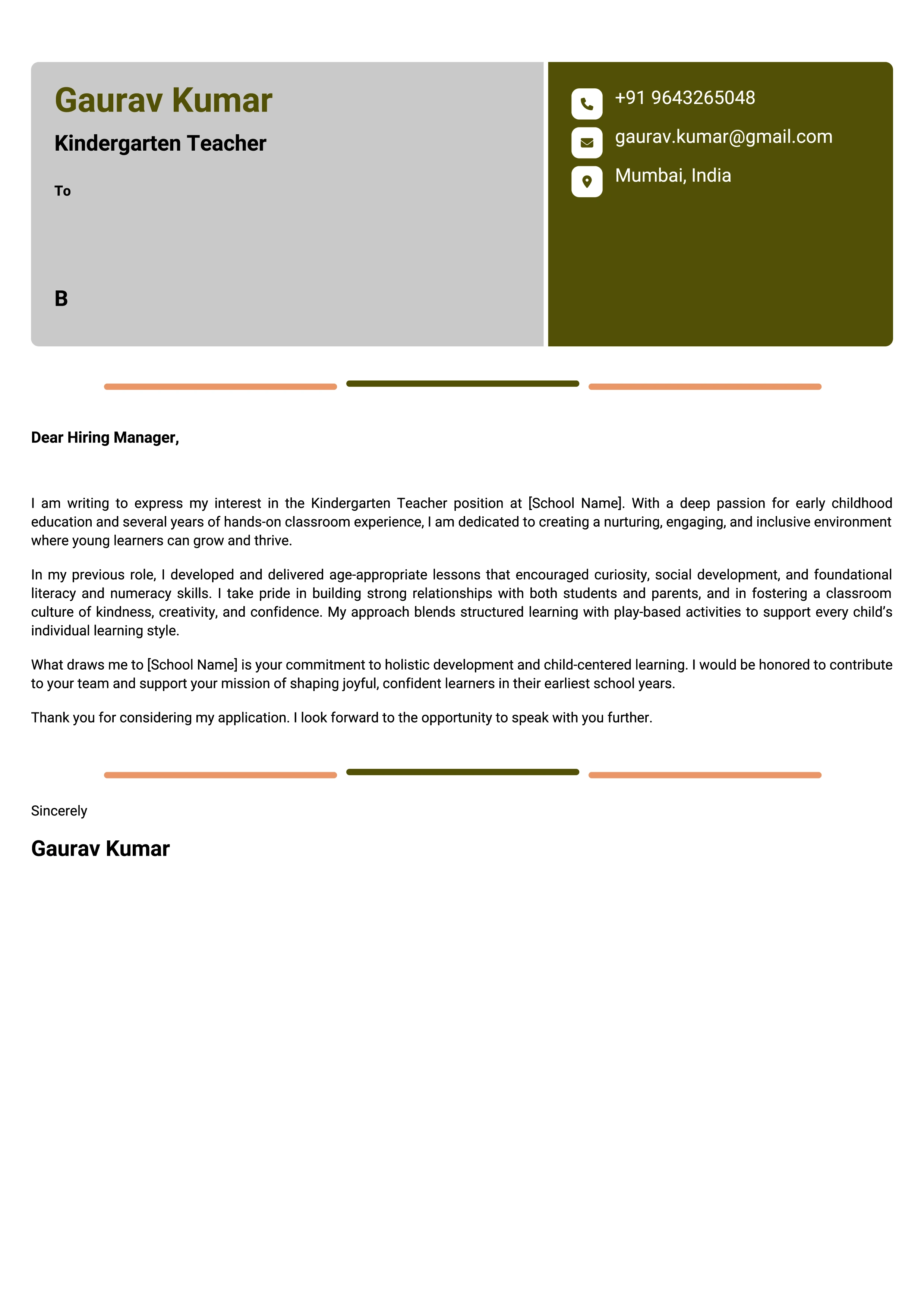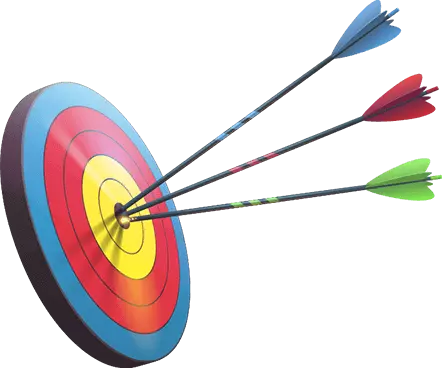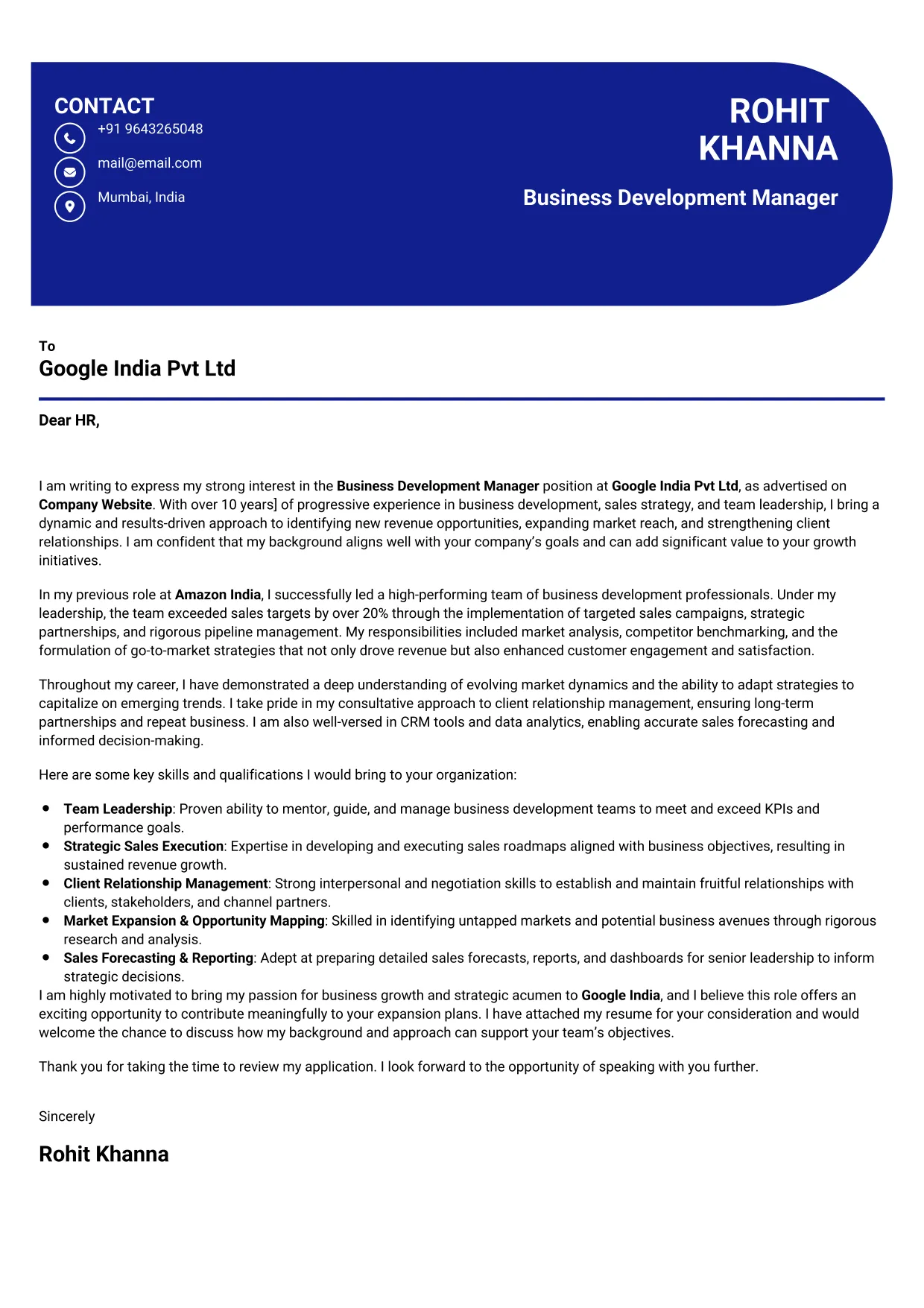Kindergarten Teacher
Welcome to our Kindergarten Teacher cover letter sample page! This professionally designed template is crafted to highlight your passion for early childhood education, expertise in child development, and proven ability to create a nurturing and engaging learning environment for young children. Whether you’re teaching in public, private, or Montessori schools, this sample emphasizes key skills like early literacy, numeracy development, play-based learning, classroom management, social-emotional learning (SEL) support, and effective communication with parents and colleagues. Tailored to meet 2025 employer expectations, this guide will help you create a compelling cover letter that stands out in the competitive education sector and secures your next impactful teaching opportunity.

Superbresume.com empowers Kindergarten Teachers to craft cover letters that showcase their dedication to foundational learning. Our platform provides customizable templates tailored for early childhood education roles, emphasizing expertise in child development, engaging lesson design, and fostering positive social interactions. With ATS-optimized formats, expert-written content suggestions, and real-time feedback, we ensure your cover letter aligns with school mission and developmental standards. Highlight achievements like improving early literacy skills, creating a vibrant and inclusive classroom, fostering a love for learning, or implementing innovative play-based learning strategies with confidence. Superbresume.com helps you create a polished, results-driven cover letter that grabs hiring managers’ attention and lands interviews in forward-thinking school districts.
How to Write a Cover Letter for a Kindergarten Teacher
Address the Hiring Manager: Use the hiring manager’s name (e.g., “Dear Principal Green”) to personalize the letter and show attention to detail.
Highlight Relevant Experience: Focus on your experience with early literacy and numeracy instruction, play-based learning activities, positive classroom management, assessing developmental milestones, and supporting children’s social-emotional growth.
Quantify Achievements: Use metrics (where possible and appropriate), e.g., “Helped 90% of students achieve reading readiness benchmarks by year-end,” or “Developed a new sensory learning station that increased student engagement in science by 20%.”
Incorporate Keywords: Include terms like “early childhood education,” “kindergarten readiness,” “play-based learning,” “early literacy,” “numeracy skills,” “social-emotional learning (SEL),” “classroom management (positive),” “differentiated instruction (early learners),” “parent communication,” or “child development” from the job description to pass ATS filters.
Showcase Pedagogical Expertise: Mention specific teaching philosophies (e.g., Montessori, Reggio Emilia) or approaches to early learning that you apply.
Emphasize Student Engagement & Creativity: Highlight your ability to design hands-on activities that foster curiosity, exploration, and a love for learning.
Demonstrate Communication & Collaboration: Include examples of effectively communicating with parents, colleagues, and school administration about student progress and well-being.
Keep It Concise: Limit the cover letter to one page, focusing on your most impactful contributions to young children's foundational learning.
Close with Enthusiasm: End with a strong call to action, e.g., “I am eager to contribute my dedication to early childhood development and creative teaching methods to [School Name]'s kindergarten program.”
Social-Emotional Learning (SEL) Deep Integration: Stronger emphasis on explicit SEL curricula, emotional regulation strategies, and fostering positive peer relationships in the classroom.
Technology Integration (Age-Appropriate): Showcase proficiency in using interactive whiteboards, educational apps, and tablets in a developmentally appropriate manner to enhance learning.
Data-Informed Instruction (Early Childhood): Highlight ability to collect and interpret early assessment data to inform differentiated instruction and identify developmental needs.
Culturally Responsive Teaching: Emphasize strategies for creating an inclusive classroom that respects diverse family backgrounds, languages, and cultures.
Outdoor & Nature-Based Learning: Experience in incorporating outdoor play, nature exploration, and environmental education into the kindergarten curriculum.
Early STEM/STEAM Education: Focus on engaging young learners in foundational science, technology, engineering, arts, and mathematics through hands-on activities.
Positive Behavior Interventions and Supports (PBIS) Awareness: Familiarity with school-wide systems for promoting positive behavior.
Choose Superbresume.com to craft a Kindergarten Teacher cover letter that truly sparks young minds. Our platform offers tailored templates optimized for ATS, ensuring your expertise in early literacy, child development, and engaging play-based learning shines. With expert guidance, pre-written content, and real-time feedback, we help you highlight achievements like improving foundational skills, fostering a love for learning, or creating vibrant classroom communities. Whether you’re starting a child's educational journey or refining your approach, our tools make it easy to create a polished, results-driven cover letter. Trust Superbresume.com to showcase your dedication and secure interviews in nurturing early childhood environments.
20 Key Skills for a Kindergarten Teacher Cover Letter
| Early Literacy Instruction (Phonics, Sight Words) | Numeracy Development (Counting, Basic Math) |
| Play-Based Learning | Classroom Management (Positive Reinforcement) |
| Child Development Knowledge (Ages 4-6) | Social-Emotional Learning (SEL) Support |
| Lesson Planning (Age-Appropriate) | Differentiated Instruction (Early Learners) |
| Student Assessment (Developmental) | Parent Communication & Collaboration |
| Creative Arts & Crafts Integration | Storytelling & Reading Aloud |
| Technology Integration (EdTech for EC) | Conflict Resolution (Child) |
| Patience & Empathy | Classroom Setup & Organization |
| Adaptability (Child Needs) | Behavior Management |
| Team Collaboration | Positive Reinforcement |
10 Do’s for a Kindergarten Teacher Cover Letter
Lead with Passion for Early Learning
Highlight Child Development Knowledge
Quantify Achievements
Showcase Engaging Activities
Include Classroom Management
Optimize for ATS
Keep It Professional & Nurturing
Mention Parent Communication
Proofread Meticulously
10 Don’ts for a Kindergarten Teacher Cover Letter
Don’t Be Vague About Teaching Methods
Don’t Exceed One Page
Don’t Skip Classroom Management
Don’t Use Complex Formats
Don’t Omit Social-Emotional Learning
Don’t Focus Only on Academics
Don’t Ignore Play-Based Learning
Don’t Include Irrelevant Experience
Don’t Forget to Update
5 FAQs for a Kindergarten Teacher Cover Letter
Prioritize early literacy/numeracy, play-based learning, classroom management, child development knowledge, and parent communication.
Use standard formatting, avoid graphics, and include keywords like “early childhood education,” “kindergarten readiness,” “social-emotional learning,” and specific teaching philosophies from the job description.
Yes, if you have experience with developmentally appropriate assessments (e.g., running records, anecdotal observations, DIBELS), it demonstrates your understanding.
Describe how you create a curious and engaging environment through hands-on activities, thematic units, storytelling, or encouraging exploration that sparks children's natural curiosity and enthusiasm for learning.
Use a professional, enthusiastic, nurturing, and patient tone, conveying your dedication to providing a foundational and joyful learning experience for young children.
Get 5x more interviews with our crafted Resumes. We make Cover Letter that land jobs.

Free Customized Cover Letter + Expert Resume Advice
Receive a professionally tailored cover letter absolutely free with every resume order—plus expert guidance to make your resume stand out.
